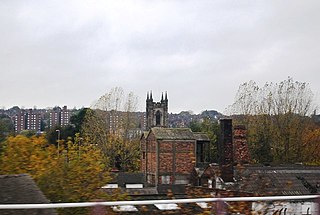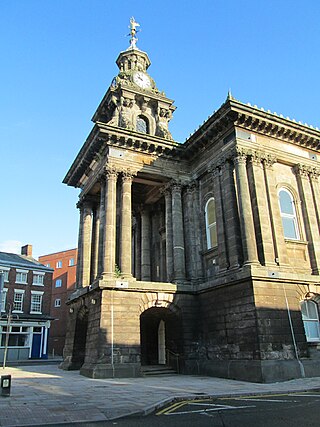
Stoke-upon-Trent, also known as Stoke, is one of the six towns that along with Hanley, Burslem, Fenton, Longton and Tunstall form the city of Stoke-on-Trent, in Staffordshire, England.

Stoke-on-Trent is a city and unitary authority area in Staffordshire, England, with an area of 36 square miles (93 km2). In 2022, the city had an estimated population of 259,965. It is the largest settlement in Staffordshire and is surrounded by the towns of Newcastle-under-Lyme, Alsager, Kidsgrove and Biddulph, which form a conurbation around the city.

The North Staffordshire Railway (NSR) was a British railway company formed in 1845 to promote a number of lines in the Staffordshire Potteries and surrounding areas in Staffordshire, Cheshire, Derbyshire and Shropshire.

Burslem is one of the six towns that along with Hanley, Tunstall, Fenton, Longton and Stoke-upon-Trent form part of the city of Stoke-on-Trent in Staffordshire, England. It is often referred to as the "mother town" of Stoke on Trent. The population of the town was included under the Burslem Central ward and had a population of 6,490 in the 2021 Census.

Tunstall is one of the six towns that, along with Burslem, Longton, Fenton, Hanley and Stoke-upon-Trent, amalgamated to form the City of Stoke-on-Trent in Staffordshire, England. It was one of the original six towns that federated to form the city. Tunstall is the most northern, and fourth largest town of the Potteries. It is situated in the very northwest of the city borough, with its north and west boundaries being the city limit. It stands on a ridge of land between Fowlea Brook to the west and Scotia Brook to the east, surrounded by old tile-making and brick-making sites, some of which date back to the Middle Ages.

Stoke-on-Trent railway station is a mainline railway station serving the city of Stoke-on-Trent, on the Stafford to Manchester branch of the West Coast Main Line. It also provides an interchange between local services running through Cheshire, Staffordshire and Derbyshire.

Stafford railway station is a major interchange railway station in Stafford, Staffordshire, England, and is the second busiest railway station in Staffordshire, after Stoke-on-Trent. The station serves the market and county town, as well as surrounding villages. The station lies on the junction of the Trent Valley line, the Birmingham Loop/Rugby–Birmingham–Stafford line, and the West Coast Main Line.

Barlaston is a village and civil parish in the borough of Stafford in the county of Staffordshire, England. It is roughly halfway between the city of Stoke-on-Trent and the small town of Stone. According to the 2001 census the population of the parish was 2,659, rising at the 2011 Census to 2,858.

Uttoxeter railway station serves the town of Uttoxeter, Staffordshire, England. It is on the Crewe–Derby line, which is also a Community rail line known as the North Staffordshire line. The station is owned by Network Rail and managed by East Midlands Railway.

Trentham is a suburb of the city of Stoke-on-Trent in North Staffordshire, England, south-west of the city centre and south of the neighbouring town of Newcastle-under-Lyme. It is separated from the main urban area by open space and by the Trent and Mersey Canal and the River Trent, giving it the feel of a village.

Etruria Hall in Etruria, Stoke-on-Trent, Staffordshire, England is a Grade II listed house and former home of the potter Josiah Wedgwood. It was built between 1768–1771 by Joseph Pickford. The hall was sold by the Wedgwoods in the 19th century and is now part of a hotel.

Longport is an area of Stoke-on-Trent, England. It is the location for Longbridge Hayes industrial estate.

Barlaston Hall is an English Palladian country house in the village of Barlaston in Staffordshire, on a ridge overlooking the valley of the River Trent to the west, about 5 miles (8.0 km) south of Stoke-on-Trent, with the towns of Stone about 4 miles (6.4 km) to the south, and Stafford about 11 miles (18 km) south.

The Wedgwood Institute is a large red-brick building that stands in Queen Street, in the town of Burslem, Stoke-on-Trent, Staffordshire, England. It is sometimes called the Wedgwood Memorial Institute, but it is not to be confused with the former Wedgwood Memorial College in Barlaston. It achieved listed building status in 1972.

Sandon railway station was a railway station opened by the North Staffordshire Railway to serve the village of Sandon, Staffordshire, England.

The North Stafford Hotel is a Grade II* listed hotel in Stoke-on-Trent, Staffordshire, England, opposite the city's railway station, also a Grade II* listed building.

Colwich railway station is a disused railway station in Colwich, Staffordshire, England. The former station is adjacent to Colwich Junction, where the Trent Valley Line to Stafford and the cut-off line to Stoke-on-Trent diverge.

The Old Town Hall is a former town hall in Burslem, in Staffordshire, England. It is in the Market Place, in the centre of the town. It is a Grade II* listed building, listed on 2 October 1951.

Hanley Town Hall is a municipal building in Albion Square in Hanley, Staffordshire, England. The building, which is used as the local register office, is a Grade II listed building.



















